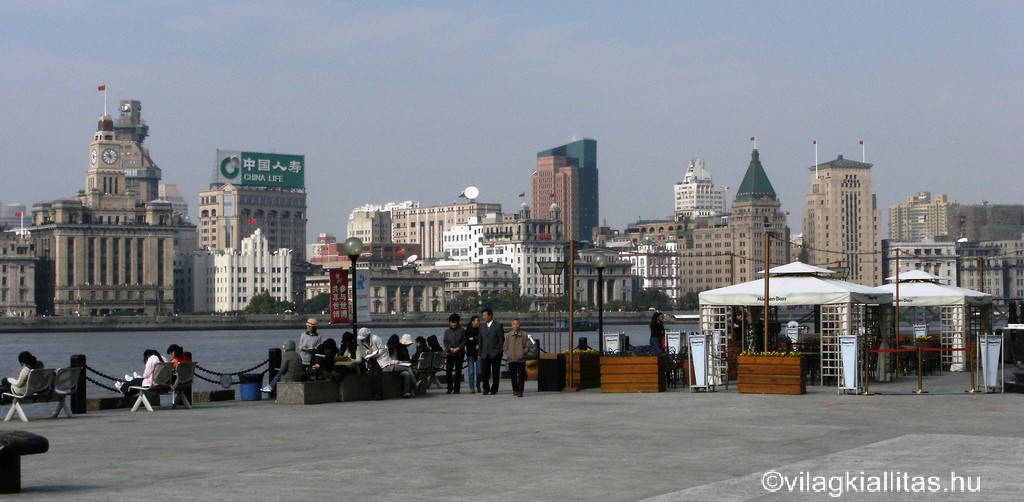|
|


ADVERTISEMENT
Buy Your own advertising
spaces!
.
Download Adobe Acrobat Reader to open [PDF] files.
Recent Visitors
China Exclusive: 60 years of changes in eyes of the Bund
2009. 7 October
 photo by Rádai
photo by Rádai
(english.people.com.cn)
Building of the former British Consulate, the oldest structure at the Bund of Shanghai is being restored to greet the World Expo 2009 that is to start next May.
The restoration was part of the "Bund Origin" program, which involves conservation-oriented development of 14 historic buildings for banks, churches and apartments and hotels.
Gao Wenlan looked at the buildings through the windows of her apartment." Though the old buildings are still there, the Bund is now totally different," she told Xinhua Tuesday.
Gao, 96, has been living in the Bund area for over 60 years and witnessed the changes around it.
After the Opium War in 1840, Shanghai was forced to open to the outside world. The Bund became the earliest concession area in Shanghai and was turned into the "Oriental Wall Street" later.
Hong Kong and Shanghai Banking Corporation (HSBC) built two business halls at the Bund, one for foreigners, on the main street, and the other for Chinese, on the side road.
The different treatment could be also seen in "The Bund Park", where Chinese were hardly seen.
"I hardly went there. The guard at the gate decided on whether to allow your entrance by your dress and his mood," Gao said.
Things changed after the founding of People's Republic of China(PRC).
The name of "The Bund Park" was changed into "Huangpu Park", and the park opened to all Chinese.
"I often went there with my friends," said Gao's daughter Chen Yajun, 69. "People took photos, drank tea and walk after meal in the park."
Chinese organizations including Shanghai Municipal Government established offices in the buildings where foreign banks and British consulate had been doing business before.
"The bund started to become the symbol of Shanghai in eyes of both local residents and visitors," said Wu Jiang, vice president of Tongji University based in the city and former deputy head of administration of city planning of Shanghai Municipal Government.
In the nearly 30 years since 1949, pictures of the Bund could be seen on bags and chinaware produced in Shanghai. Wu still keeps a picture of one of those products.
After China's reform and opening up drive was initiated in 1978,the Bund has gradually become a main hub for transportation after the rail trolley bus was abandoned and tar was paved on the road.
Despite the changes of the function, couples promenading and sitting along the embankment against the Huangpu River to enjoy their sweet time constituted a famous landscape of the Bund, "the Sweet Hearts' Wall", in the early era of the nation's opening-up drive.
"Every time I planned to go there with my girlfriend, we should get there as early as possible, because there were always crowds of couples to compete for their space," said Lu Zhenhua, 57.
Shanghai citizens turned their aversion into fondness for the Bund and gave the area another name, "foreign buildings exposition".
According to Wu, when the queen of Britain visited Shanghai in 1980s, appearances of the Bund buildings were refreshed from top to bottom.
Besides the function of government offices, the Bund served as a rendezvous for people to watch colorful lights on such major holiday as the National Day.
In 1990s, Shanghai made strides in rebuilding the "Oriental Wall Street", and financial institutions came back to the Bund since 1994.
The former 8-lane road was widened into a 12-lane thoroughfare at the Bund area.
"But the traffic became heavier on the 12-lane road," said Lu, who has driving experience for over 20 years.
The improvement of infrastructures there made the Bund unfit for couples and visitors like before.
In the late 1990s, high-level hotels and franchised stores for world top luxury brands like Armani and Cartier were introduced into the Bund, providing gathering places for those company leaders.
Chen Yajun said, "I believe that the most appropriate function of the Bund is not to develop into a financial center of Shanghai,but to provide places for people to gather and consume."
In 2008, project to build a 3,000-meter-long underground road started at the Bund, which is set for completion before World Expo Shanghai in 2010.
"I believe the Bund will be nice next year,"said Kevin Mclean, who came to Shanghai from Britain during China's National Day holiday this year for the first time.
Source: english.people.com.cn


